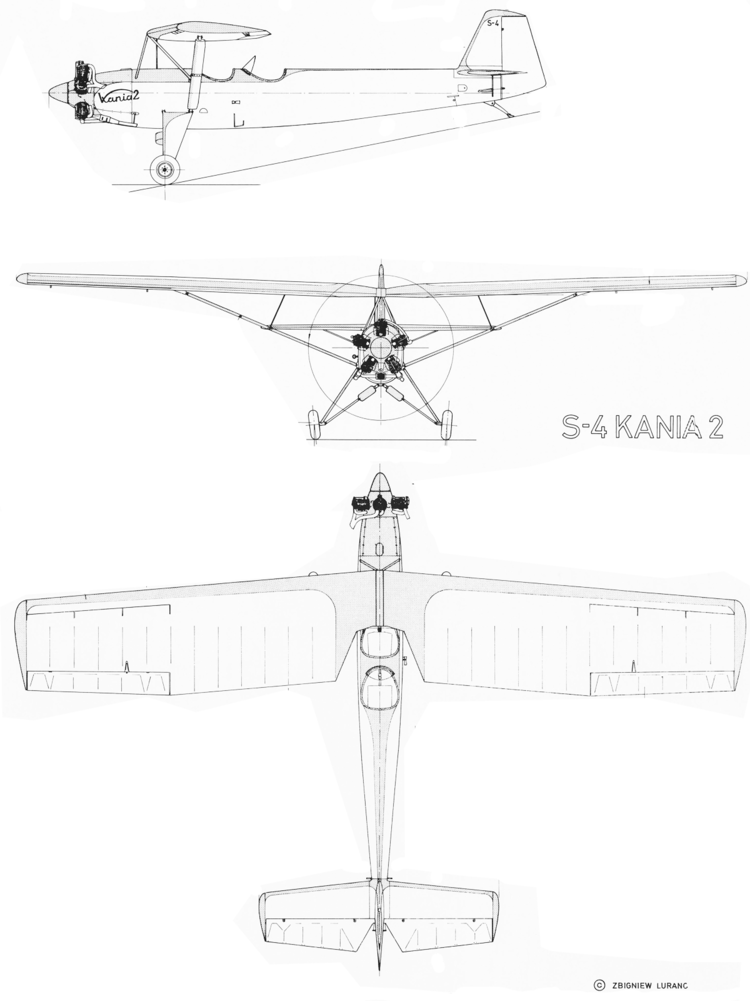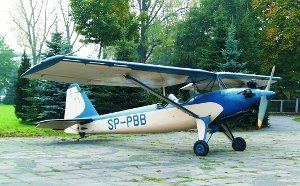Top speed 171 km/h Length 8.72 m | Wingspan 12 m First flight May 17, 1951 | |
 | ||
The PZL S-4 Kania was a Polish trainer and glider towing aircraft of the 1950s, not built in series. The first prototype was designated S-3 Kania. There is also a helicopter named PZL Kania.
Contents

Design and development

The aircraft was designed by Eugeniusz Stankiewicz in 1950, its primary purpose was towing gliders. The first prototype was named S-3 Kania (kite (bird), S for Stankiewicz, it probably had no PZL prefix). It was built in the Szybowcowy Zakład Doświadczalny (SZD, Glider Experimental Works) in Bielsko-Biała and first flew on 17 May 1951. It appeared quite successful, and was cheaper in production and service, than the CSS-13 (licensed Polikarpov Po-2), but was not produced, because the Aviation Institute (Instytut Lotnictwa, IL) found some lacks in calculations and too weak landing gear. The work ceased, while the prototype was abandoned to ruin.

In 1956, the design was taken over by WSK-Mielec factory (partly due to an interest of the press, combined with shortages of aircraft in aero clubs). It was developed and improved by Stankiewicz's team and on 2 September 1957, a new prototype, the PZL S-4 Kania-2, was flown. On 19 September 1958, another further improved prototype, the PZL S-4 Kania-3, flew, with enlarged tailfin. This underwent state trials in 1960 with good results. It offered good handling and was useful to training, glider towing, and basic aerobatics. It could tow 2 or 3 gliders at a time. The S-4 did not enter production, though, because due to a long development, the design had become dated. At that time, it was preferred to use metal aircraft in aeroclubs, and the PZL-104 Wilga was in development. The other thing was, production of the obsolete M-11 engine had ceased in Poland.

Work on the third S-4 prototype was suspended. It was completed only in 1964 by the Aircraft Repair Works in Krosno.
Operational history

The first S-4 Kania-2 prototype (registration SP-PAA) was shown on World Glider Championships in Leszno in 1958, among others it hauled several gliders. Along with the second S-4 prototype (registration SP-PBB), it was used by the aero club in Mielec. The third S-4 prototype was used in Krosno (registration SP-PBE). The second prototype was written off in the end of 1970, the rest around the same.
Operators

Survivors
The second prototype S-4 Kania-3 (SP-PBB) is preserved in the Polish Aviation Museum in Kraków, from 1971.
Description

Wooden construction high-wing monoplane (parasol wing), conventional in layout. Semi-monocoque fuselage. Crew of two, sitting in tandem, in open cockpits with windshields. Fixed conventional landing gear. Two-blade propeller. Fuel tanks 165 l.
General characteristics
Performance
